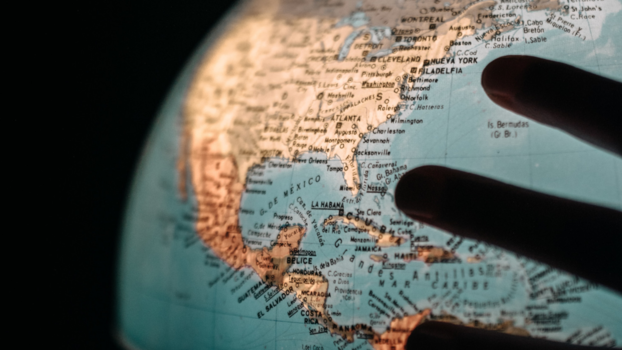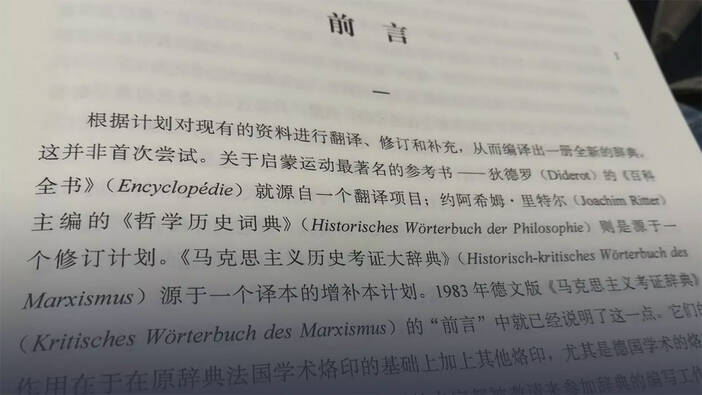
The Historical-Critical Dictionary of Marxism (HCDM) is a comprehensive Marxist lexicon which, upon completion, will span 15 volumes and over 1,500 entries. Of the nine volumes published so far in the original German, two volumes have been published in Chinese since 2017. In 2019, the Rosa-Luxemburg-Stiftung teamed up with the HCDM team to advance its "globalization" into English and Spanish, with the ultimate aim of recruiting a new generation of Marxist scholars from around the globe to the project and expanding its readership and reach. The below entry is one of a selection of these translations that are made available on our website.
For more information about the project and other translated entries, check out our HCDM dossier.
A: naẓarīyat al-cawālim al-thalātha. - F: théorie des trois mondes. - G: Drei-Welten-Theorie. - R: teorija trech mir. - S: teoría de los tres mundos. - C: san’ge shijie huafen de lilun 三个世界划分的理论
The TWT is based on a remark made by Mao Zedong on 22 February 1974 (during his talks with President K. Kaunda of Zambia): “In my view, the United States and the Soviet Union form the first world. Japan, Europe and Canada, the middle section, belong to the second world. We are the third world. […] The third world has a huge population. With the exception of Japan, Asia belongs to the third world. The whole of Africa belongs to the third world, and Latin America too.” The statement was first publicised in Renmin Ribao, the official organ of the CPC, on 1 November 1977. However, its impact on Chinese foreign policy was already on display in Deng Xiaoping’s speech at the U.N. General Assembly on 10 April 1974. Deng quoted Mao’s expression without naming the author, and then went on to emphasise the political core of the TWT: “The two superpowers, the United States and the Soviet Union, are vainly seeking world hegemony. Each in its own way attempts to bring the developing countries of Asia, Africa and Latin America under its control and, at the same time, to bully the developed countries that are not their match in strength.”
China’s break with the Soviet Union – one of the prerequisites to the formulation of the TWT – that began in the late 1950s and fully came to a head in the mid-1960s on the heels of The Polemic on the General Line of the International Communist Movement (1963/64) had historical roots that can be traced back to the 1930s. Early on, the CPC showed some resistance towards Comintern and CPSU policies as far as the Chinese revolution was concerned. Under Mao’s leadership, the CPC pursued an independent path, particularly with regard to questions surrounding the revolution’s main force (peasants rather than the industrial proletariat) and policies concerning alliances towards the Guomindang. Stemming from traditional Sino-centric modes of thinking (“Middle kingdom”) and the self-confidence that sprang from a victorious revolution, fought solely on one’s own and, in part, against Soviet instructions, China inevitably claimed a special role in the “socialist camp” – one which opposed being subordinated under Soviet leadership. The power politics of the USSR after 1949, especially the attempts to incorporate China into Soviet military-political concepts (including, for example, requests to establish Soviet naval bases on Chinese territory), further fuelled Chinese tendencies to keep an increasing distance from the SU. In addition, China viewed itself as a “poor” and underdeveloped country at the outset, that could neither compete with the developed capitalist states nor with the developed socialist ones (nuclear weapons and space technology in the SU). Thus, from 1955 (Bandung Conference) China enhanced its foreign policy engagement with the “non-aligned” states, especially across the Global South (tricont).
The Sino-Soviet rupture and the split of the “socialist camp” that it caused, put China in a difficult position. The Chinese leadership reached the conclusion that the threat posed to China by the Soviet Union outweighed the dangers of US imperialism; at the same time, great importance was placed on inner-imperialist contradictions. China had to find new allies. By order of importance, they were: 1. socialist states that remained friendly to China (Albania, North Korea, partially also North Vietnam and Romania); 2. the “Third World”; 3. “Second World” states seeking to evade the superpowers’ influence; 4. the United States as the “less dangerous superpower”. Thus, the formulation of the TWT essentially signalled an end to foreign policy reorientation.
It was only after the fact that the TWT was substantiated in reference to the writings of the “classics”, particularly – as is typical in the context of Chinese Marxism-Leninism – to those of Lenin, Stalin, and Mao. In Chairman Mao’s Theory (1977), the correctness of the strategy to form an alliance with the “Third World” was corroborated, inter alia, by Lenin’s 1916 assessment: “The social revolution can come only in the form of an epoch in which are combined civil war by the proletariat against the bourgeoisie in the advanced countries and a whole series of democratic and revolutionary movements, including the national liberation movement, in the undeveloped, backward and oppressed nations.” (CW 23/60 [23/53]). Also the division into several “worlds” was placed in a tradition stemming from Lenin: “The characteristic feature of imperialism consists in the whole world, as we now see, being divided into a large number of oppressed nations and an insignificant number of oppressor nations” (CW 31/240 [31/228]). “[U]nfortunately, there are now two worlds: the old world of capitalism […] and the rising new world” (CW 33/149 et sq. [33/132]). Stalin: “The world has definitely and irrevocably split into two camps: the camp of imperialism and the camp of socialism.” (Wks 4/240 [4/205]) – So far, only a dichotomous division of the world had been defined. But Stalin also conceptualised a second division, which could be understood as running straight through the first one: “The world is divided into two camps: the camp of a handful of civilized nations, which possess finance capital and exploit the vast majority of the population of the globe; and the camp of the oppressed and exploited peoples in the colonies and dependent countries, which constitute that majority.” (Wks 6/149 et sq. [6/127])
As both practitioner and theoretician of such a country, Mao concluded in 1940: “This [world] revolution has the proletariat of the capitalist countries as its main force and the oppressed peoples of the colonies and semi-colonies as its allies. No matter what classes, parties or individuals in an oppressed nation join the revolution, and no matter whether they themselves are conscious of the point or understand it, so long as they oppose imperialism, their revolution becomes part of the proletarian-socialist world revolution and they become its allies.” (SelWks II/346 et sq. [AW II/404]). Later, when the TWT came to determine the foreign policy of the PR China, this assessment was employed as a justification for disregarding class antagonisms within “Third World” countries and attaching importance only to the antagonisms between these countries and the “superpowers”. Mao’s final departure from the dichotomous division of the world, as Lenin and Stalin had expounded it, came in January 1957: “The contradiction between the imperialist countries and the socialist countries is certainly most acute. But the imperialist countries are now contending with each other for the control of different areas in the name of opposing communism. What areas are they contending for? Areas in Asia and Africa inhabited by 1,000 million people. […] [T]wo kinds of contradictions and three kinds of forces are in conflict. The two kinds of contradictions are: first, those between different imperialist powers, that is, between the United States and Britain and between the United States and France and, second, those between the imperialist powers and the oppressed nations. The three kinds of forces are: one, the United States, the biggest imperialist power, two, Britain and France, second-rate imperialist powers, and three, the oppressed nations.” (SelWks V/361 et sq. [AW V/408 et sq.]) Basically, the “three worlds” that would subsequently find their way into the TWT were thus already named, only the SU still had to be assigned to the category of the superpowers.
The CPSU criticised this “new theory”, “according to which the chief contradiction of our time is not […] between socialism and imperialism, but between the national-liberation movement and imperialism” (The Polemic, 1965, 200 et sq. [Die Polemik, 1965, 225]), whereas the CPC in turn condemned the CPSU for having abandoned the aforementioned positions Lenin and Stalin took regarding national liberation movements (197-203 [221-27]). Mao himself never advocated for a “TWT” in any of his known written or oral statements; on the contrary, he seems to have prevented the publication of his statements from 22 February 1974 for as long as he was alive. The formulation of the TWT as “a major contribution to Marxism-Leninism” only appeared in 1977, one year after Mao’s death. As a foreign policy concept, however, he developed and supported it.
Charles Bettelheim argued in 1978 (129, note 70) that TWT had no scientific basis and did not correspond to any reality. “It wrongly assumes that, as between the ‘Second’ and the ‘Third’ worlds, unity can have primacy over contradiction, an idea which runs counter to everything taught us by history, past and present. History reveals the deep conflicts which set many of the countries of the ‘Second’ and the ‘Third’ worlds against each other”. The TWT “buries the class contradictions involved, to say nothing of the contradictions between countries.”
The TWT de facto remained a tactical foreign policy concept after Mao’s death. It never turned into a theory based on concrete analysis. Rather it was derivative of certain, little substantiated theoretical specifications, e.g. the SU being “social imperialist”, “social fascist” and “state capitalist”. As these presuppositions were dropped in the early 1980s and the accusations against the CPSU as being revisionist were finally revoked, the TWT disappeared as well. It, thus, cannot be understood as a strategic concept. Instead, it depended in its entirety on the short-term tactical assessment of the SU. At least two basic elements of the TWT remained relevant for Chinese foreign policy: the orientation towards the “Third World” and its national liberation movements, and the resistance to imperialist “hegemony”.
At the beginning of the 1990s, when the reform policy of “socialist market economy” led to a soaring economic upturn in China while the SU fell apart, this, too, became obsolete. China’s foreign policy was reoriented once again, focussing on the industrial nations. The country's national interests, especially the economic ones, increasingly came into conflict with the interests of other states in the Global South (tricont).
Bibliography: C.Bettelheim, “The Great Leap Backward”, Monthly Review, vol. 30, 1978, no. 3; “Chairman Mao’s Theory of the Differentiation of the Three Worlds Is a Major Contribution To Marxism-Leninism”, 1 November 1977, Peking·Review, vol. 20, 1977, no. 45, 10-43; Die Theorie der Drei Welten, 2 vols., ed. by ZK der Marxisten-Leninisten Deutschlands, Frankfurt/M 1978 (Dokumente I: Die Theorie der Drei Welten. Die Klassenlinie im Internationalen Kampf des Proletariats. Dokumente der KPCh und der Partei der Arbeit Albaniens; Dokumente II: Der Vormarsch der Drei-Welten-Theorie Mao Tsetungs); Deng Xiaoping, “Speech at Special Session of U.N. General Assembly (10 April 1974)”, Peking Beijing Review, vol. 17, 1974, no. 15, special supplement; The Polemic on the General Line of the International Communist Movement, Beijing 1965.
Ingo Nentwig
Translated by Hauke Neddermann
→ Chinese Cultural Revolution, Chinese revolution, hegemonism, ideas of Mao Zedong, Maoism, non-alignment, socialist market economy, superpowers, third world, tricontinent
→ Blockfreiheit, chinesische Kulturrevolution, chinesische Revolution, Dritte Welt, Hegemonismus, Maoismus, Mao-Zedong-Ideen, sozialistische Marktwirtschaft, Supermächte, Trikontinent
Originally published as Drei-Welten-Theorie in: Historisch-kritisches Wörterbuch des Marxismus, vol. 2/I: Bank bis Dummheit in der Musik, edited by Wolfgang Fritz Haug, Argument-Verlag, Hamburg 1995, col. 830-834.
